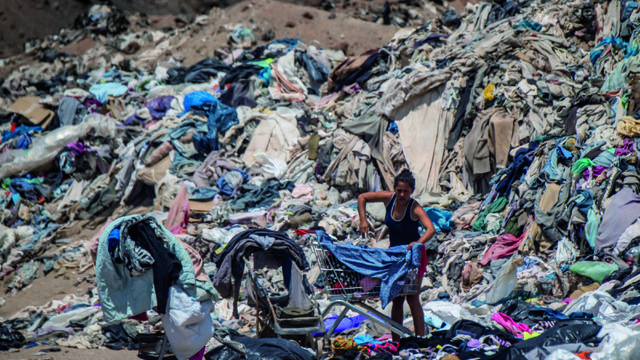28
03/2023
AFP / Iquique (Chile)
The desired garment, the ideal size and the dream brand: it is not a large store or a generous closet but the Atacama desert in Chile turned into a clandestine dump of clothes that are bought, worn and thrown away in the United States, Europe and Asia.
Colorful hills rise out of the desolate landscape. They are squads that grow as some 59,000 tons per year enter through the Iquique free zone, 1,800 kilometers from Santiago.
The excessive and fleeting consumption of clothing, with chains capable of releasing more than 50 seasons of new products per year, has caused textile waste to grow exponentially in the world, which takes about 200 years to disintegrate.
This is clothing made in China or Bangladesh and bought in Berlin or Los Angeles, before being thrown away. At least 39,000 tons end up as garbage hidden in the desert in the Alto Hospicio area, in northern Chile, one of the final destinations for "second-hand" clothing or from past seasons of fast fashion chains.
Chile is the leading importer of used clothing in Latin America. For nearly 40 years there has been a solid trade in "American clothing" in stores throughout the country, which are supplied with bundles purchased by the free zone in the north of the country from the United States, Canada, Europe and Asia.
“These clothes come from all over the world,” explains Álex Carreño, a former worker in the import zone of the port of Iquique, who lives next to a clothing dump.
In this area of importers and preferential taxes, merchants from the rest of the country select the garments for their stores and what is left over cannot go through customs in this region of just over 300,000 inhabitants.
“What was not sold to Santiago or went to other countries (such as Bolivia, Peru and Paraguay for smuggling), then stays here because it is a free zone,” says Carreño.
On the desert landscape there are patches of all kinds of garbage, and much of it is from clothes, handbags and shoes. Ironically, rain or sky boots stand out in one of the most arid areas of the world.

A lady who doesn't want to give her name has half her body sunk in a pile of clothes and rummages around looking for the best possible ones to sell in her neighborhood.
Elsewhere, Sofía and Jenny, two young Venezuelans who crossed the border between Bolivia and Chile a few days ago, some 350 kilometers from the dump, choose “things for the cold” while their babies crawl on textile mountains: “We come to look for clothes because we really don't have them, we threw them all away when we came backpacking here”.
Toxic fashion
Reports on the garment industry have exposed the high cost of fast fashion, with underpaid workers, allegations of child labor and deplorable conditions for mass production. Added to this today are devastating figures on its immense environmental impact, comparable to that of the oil industry.
According to a 2019 UN study, the production of clothing in the world doubled between 2000 and 2014, which has made it clear that it is an industry "responsible for 20% of the total waste of water worldwide." global".
The same report indicates that only the production of jeans (jeans) requires 7,500 liters of water, highlights that the manufacture of clothing and footwear generates 8% of greenhouse gases, and that "every second it is buried or burns an amount of textiles equivalent to a garbage truck”.
In the textile dumps of this desert, it is possible to stumble upon an American flag, a pair of polished skirts, see a “wall” of pants with labels and even step on a collection of sweaters with the Christmas motifs so popular at parties December in London or New York.
“The problem is that clothing is not biodegradable and contains chemicals, which is why it is not accepted in municipal landfills,” Franklin Zepeda, founder of EcoFibra, a circular economy firm with a production plant in Alto, told AFP. Hospice of panels with thermal insulation based on this disposable clothing.
Underground there are more garments covered with the help of municipal trucks, in an attempt to prevent fires caused and very toxic by the chemicals and synthetic fabrics that compose it.
But clothing buried or exposed also releases pollutants into the air and into the groundwater tables typical of the desert ecosystem. Fashion is as toxic as tires or plastics.

- 580
- how to recycle old clothes into new fashion youtube
Related Articles
48 Best Kids Watches in 2021 based on 623 reviews
16/05/2022If you are here, we assume that you are looking for the best watches for children. However, given the number of options available in the market, it becomes really daunting to choose the right product...
46 Best Pitchers and Decanters in 2021: According to the Experts
20/04/2022You can get any random Pitchers and Decanters, but if you're looking for expert advice to choose the best one for your needs, then you've come to the right place. No matter which...
39 Best Legumes in 2021: According to the Experts
02/03/2022You can get any random legume, but if you're looking for expert advice to choose the best one for your needs, then you've come to the right place. No matter what your...
Best Camper Kit For Vans 2022 (buying guide)
03/05/2022Technology improvement need only increase the level of competition in each market. Whether it is automobiles or electronic devices, every industry makes the best use of advanced technology...